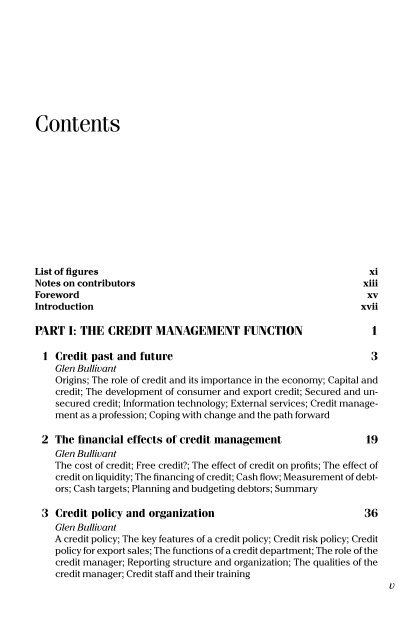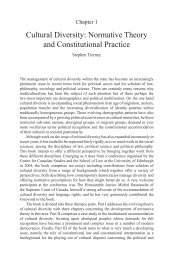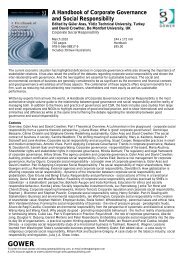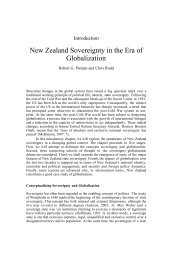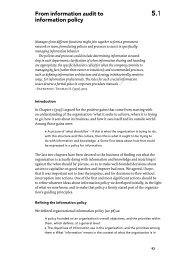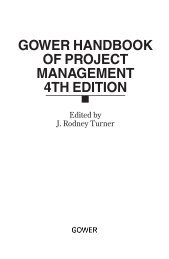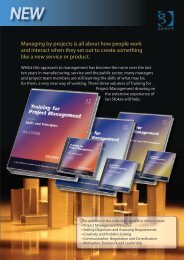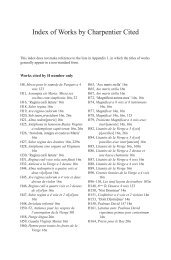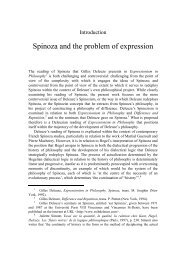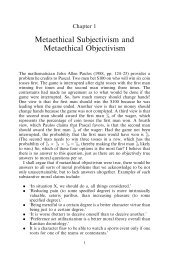Contents - Ashgate
Contents - Ashgate
Contents - Ashgate
Create successful ePaper yourself
Turn your PDF publications into a flip-book with our unique Google optimized e-Paper software.
<strong>Contents</strong><br />
List of figures<br />
Notes on contributors<br />
Foreword<br />
Introduction<br />
xi<br />
xiii<br />
xv<br />
xvii<br />
PART I: THE CREDIT MANAGEMENT FUNCTION 1<br />
1 Credit past and future 3<br />
Glen Bullivant<br />
Origins; The role of credit and its importance in the economy; Capital and<br />
credit; The development of consumer and export credit; Secured and unsecured<br />
credit; Information technology; External services; Credit management<br />
as a profession; Coping with change and the path forward<br />
2 The financial effects of credit management 19<br />
Glen Bullivant<br />
The cost of credit; Free credit?; The effect of credit on profits; The effect of<br />
credit on liquidity; The financing of credit; Cash flow; Measurement of debtors;<br />
Cash targets; Planning and budgeting debtors; Summary<br />
3 Credit policy and organization 36<br />
Glen Bullivant<br />
A credit policy; The key features of a credit policy; Credit risk policy; Credit<br />
policy for export sales; The functions of a credit department; The role of the<br />
credit manager; Reporting structure and organization; The qualities of the<br />
credit manager; Credit staff and their training<br />
v
CREDIT MANAGEMENT HANDBOOK<br />
PART II: CREDIT TERMS AND CONDITIONS OF SALE 61<br />
4 Credit terms and conditions of sale 63<br />
Glen Bullivant<br />
Credit terms; The factors affecting credit terms; Conditions of sale; Types<br />
of credit terms; Cash discounts; Late payment interest; Progress payments,<br />
retentions and consignment accounts; Methods of payment<br />
PART III: ASSESSING CREDIT RISK 79<br />
5 Assessing risks in trade credit 81<br />
Glen Bullivant<br />
Credit assessment overview; Marketing and risk assessment; Customer<br />
identity – types of customer; Trade credit information and its sources; Financial<br />
statements; Interpretation of accounts; Summary<br />
6 Credit ratings and risk categories 121<br />
Glen Bullivant<br />
Why have credit ratings?; Calculating credit ratings; Risk categories; Identifying<br />
and dealing with high-risk accounts; Bad debt reserves; Effective<br />
credit management<br />
7 Predicting corporate insolvency by computer 140<br />
Glen Bullivant<br />
Background; Developing and using a solvency model; Credit management<br />
applications<br />
8 Insolvency warning signs 146<br />
Glen Bullivant<br />
Background; Attitude; The three phases of failure; Can it be avoided?; Conclusion<br />
PART IV: SALES LEDGER 159<br />
9 Sales ledger administration 161<br />
Glen Bullivant<br />
Administration and format; Statements; Disputes and queries; Cash matching;<br />
Collection aids; Controls<br />
10 Computer systems for credit management 175<br />
Glen Bullivant<br />
System requirements; The sales ledger and customer file<br />
vi
CONTENTS<br />
PART V: CASH COLLECTION 187<br />
11 Collecting trade debts 189<br />
Glen Bullivant<br />
The front end; Collection attitudes; Days sales outstanding (DSO) and cash<br />
targets; Incentives; Computer aids to collection; Methods; The future<br />
12 Telephone collection 226<br />
Glen Bullivant<br />
The telephone; Staff; Making the call; Customer excuses; Win-win; Conclusion<br />
13 Using collection agencies 246<br />
Glen Bullivant<br />
The collection agency; The right agency?; Choosing the agency; The CSA<br />
14 Planning, measuring and reporting debtors 251<br />
Burt Edwards<br />
The need to plan debtors and then to report the results; The powerful tool<br />
– the DSO ratio; Budgets and reports; Measurable items<br />
PART VI: CREDIT INSURANCE 275<br />
15 Home trade credit insurance 277<br />
T Glyndwr Powell<br />
Introduction; Features of credit insurance policies; When does cover commence?;<br />
Benefits of credit insurance; Importance of brokers; Captives and<br />
mutuals; Domestic credit insurers; Further reading; Useful addresses<br />
16 Export credit insurance 295<br />
T Glyndwr Powell<br />
Introduction; Differences between domestic and export credit insurance;<br />
Country (political) risks; Commercial (customer) risks; Pre-shipment<br />
cover: suitable for companies making specialist goods to order and not<br />
easily resold elsewhere; Level of indemnity; Credit insurance compared to<br />
confirmed letters of credit; Sources of export cover; The UK’s governmentsupported<br />
export credit agency – ECGD – and medium-term credit; Further<br />
reading; Useful addresses<br />
vii
CREDIT MANAGEMENT HANDBOOK<br />
PART VII: EXPORT CREDIT AND FINANCE 305<br />
17 Export credit and collections 307<br />
Burt Edwards<br />
Exporting is expensive – so manage the expense!; Time and cost in export<br />
payments; Effective conditions of sale; Agents, distributors and subsidiaries;<br />
Export documents; Payment terms; Countertrade; Tender and performance<br />
bonds; Getting funds transferred from abroad; Checking the risk of payment<br />
delays; Information on country (political) risks; Information on customer<br />
risks; Evaluating customer risks; Codifying information; Collecting overdues<br />
– an overview; A systematic approach; A word about foreign currency;<br />
Checklist: to speed export cash; The future for export collections; Think<br />
international<br />
18 Export finance 341<br />
Burt Edwards<br />
The need for special money for exports; Enhanced overdraft; Bill advances<br />
and negotiation; Export finance banks; Finance from letters of credit; ECGDbacked<br />
finance: medium-term credit; The international consensus<br />
19 Foreign exchange 350<br />
Burt Edwards<br />
The credit manager and foreign currency; The history of foreign exchange;<br />
Present day foreign exchange markets; Dealing operations; Press charts of<br />
foreign currency rates; Exchange risks and how to cover them; The European<br />
Monetary System and ECU, leading to the Euro; The UK and the Euro;<br />
Summary; Glossary of foreign exchange terms<br />
PART VIII: CONSUMER CREDIT 367<br />
20 Retail credit management 369<br />
Glen Bullivant<br />
Securing finance for the credit operation; Relationship with finance houses;<br />
Types of credit available; Credit policy; Controlling the risk; Collecting<br />
accounts; Collection letters by computer; Management information and<br />
reports<br />
21 Consumer credit law 396<br />
Peter C Coupe<br />
Introduction; Development of consumer credit law; The Consumer Credit<br />
Act; The Data Protection Act 1998; Other laws; Codes of practice; Conclusion<br />
and further reading<br />
viii
CONTENTS<br />
PART IX: COMMERCIAL CREDIT LAW 417<br />
22 Legal action for debt recovery 419<br />
Robert Addlestone and Gareth Allen<br />
Pre-action steps; Alternative dispute resolution (ADR); Information needed<br />
to commence proceedings; Issuing the claim form; Completing the form;<br />
Service of the claim form; The next stage; Defended actions; Enforcement<br />
23 Insolvency procedures 449<br />
Malcolm Cork<br />
Introduction; Personal insolvency; Partnerships; Corporate insolvency; Creditors’<br />
voluntary liquidation; Members’ voluntary liquidation; Receivership;<br />
Company voluntary arrangement; Administration order; Informal schemes<br />
PART X: CREDIT SERVICES 469<br />
24 Invoice financing 471<br />
Ted Ettershank<br />
What’s the difference between factoring and invoice discounting?; How<br />
does invoice financing work?; How does factoring work?; How does invoice<br />
discounting vary from factoring?; When to use factoring; Points to be aware<br />
of when considering invoice financing; Choosing a factor<br />
25 Credit cards 475<br />
Peter C Coupe<br />
Introduction; What are credit cards?; Early development in the USA; UK market<br />
development; Credit and debit card spending and borrowing; The cost<br />
of credit; The cost of payments; The cost of promoting cards; Fraud and bad<br />
debt; Chips and electronic purse<br />
26 Sales finance and leasing 492<br />
T Glyndwr Powell<br />
Introduction to sales finance; Benefits of sales finance to buyer and seller;<br />
Types of sales finance; Funding the credit advanced; Which product is best<br />
for what?; Summary; Sources of information; Further reading<br />
Appendix 515<br />
Glen Bullivant<br />
Membership organizations for credit management personnel; Training and<br />
consultancy services for credit management; Sources of credit information;<br />
Useful addresses; Useful credit publications; Query management systems;<br />
The better payment practice group; Credit policy and procedures; Suggested<br />
contents for a credit manual<br />
Index 541<br />
ix


